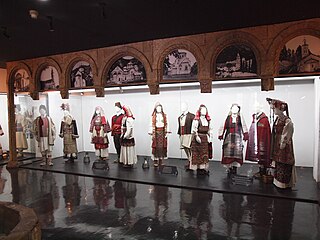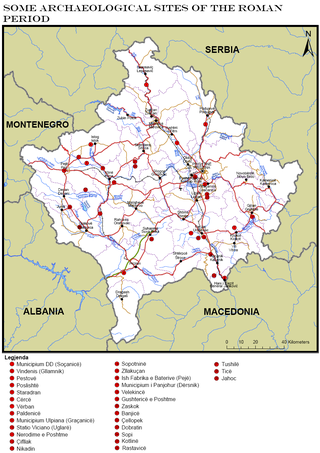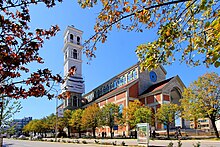
Pristina or Prishtina is the capital and largest city of Kosovo. It is the administrative center of the eponymous municipality and district.
The 2007–08 Football Superleague of Kosovo season, also known as the Raiffeisen Superleague of Kosovo for sponsorship reasons with Raiffeisen was the 10th season of top-tier football in Kosovo. The campaign began on 25 August 2007, and ended on 1 June 2008.
Tourism in Kosovo is characterized by archaeological heritage from Illyrian, Dardanian, Roman, Byzantine, Serbian and Ottoman times, traditional Albanian and Serbian cuisine, architecture, religious heritage, traditions, and natural landscapes. Kosovo is situated in south-eastern Europe. With its central position in the Balkans, it serves as a link in the connection between central and south Europe, the Adriatic Sea, and Black Sea.

Archaeology of Kosovo as a field of study and research was started in the second half of the 20th century. Kosovo's field of archaeology has developed in tandem with the historical study, studies of ancient authors' sources, classic philological studies, theological data research, topographic studies and ground survey, analysis of toponyms, deciphering of epigraphic and historiographic data. First data about antique monuments in Kosovo, were documented from the end of the 19th until the beginning of the Second World War, a time period when Kosovo was visited by researchers, guides, and archaeologists such as: Evans, Boue, Hahn, Kanitz, Tomaschek, Domaschevski, Arpad, Vulic, Jirecek, Patsch, Domenico Mustilli, etc.

Kosovo is a partially recognized state and disputed territory located in the Balkan Peninsula in Southeastern Europe. The majority of Kosovars are ethnically Albanian. Kosovo has an expansive cultural heritage, including monuments, clothing items, museums, and traditional food.

The Roman heritage sites in Kosovo represent a multitude of monuments of material and spiritual culture, which reflect the Roman period in this region. Among them, a special place is occupied by those that represent the development of art, such as the plastic monuments that are more frequent, and at the same time occupy an important place, because with the presentation of figures in relief and with numerous inscriptions they speak to us enough for this period.
Monuments of Kosovo comprise all the monuments that are located in Kosovo.

Pestova archaeological site is an archaeological site located in the village Pestova, in the municipality of Vushtrri, on the left side, stretched along the Pristina–Mitrovica road, more or less 4 km (2.5 mi) from Vushtrri. The area is known for a very fertile agricultural land, productive even in present days.

The Bazaar of Prishtina, Kosovo, was the core merchandising center of the Old Prishtina since the 15th century, when it was built. It played a significant role in the physical, economic, and social development of Pristina. The Old Bazaar was destroyed during the 1950s and 1960s, following the modernization slogan of "Destroy the old, build the new". In its place, buildings of Kosovo Assembly, Municipality of Prishtina, PTT, and Brotherhood and Unity socialist square were built. Nowadays, instead of PTT building resides the Government of Kosovo building. Only few historical buildings, such as the Bazaar Mosque and ruins of the Bazaar Hammam have remained from the Bazaar complex. Since then, Prishtina has lost part of its identity, and its cultural heritage has been scattered.

The Great Hammam of Pristina is an Ottoman-era monument in Pristina, Kosovo. It was built in the 15th century and was part of the Imperial Mosque. During the summer and spring, it was used as a meeting place. Considered one of the most important buildings of the cultural and historical heritage, the Great Hammam of Pristina was in poor condition through the years until its restoration was approved.
Kosovo does not have an official religion. Like the rest of the country, the majority of Pristina's population consider themselves to be Muslim. However, religious practices may tend to be liberal. Many do fast for Ramadan and praying is widely practiced.
Mitrovica is one of the oldest settlements in Kosovo and a very important urban ensemble. There are many traces which have special interest and prove early civilization of the territory of Mitrovica, in particular from the Illyrian inhabitation in antiquity.

As the capital city of Kosovo, Pristina is the heart of the cultural and artistic development of all Albanians that live in Kosovo. The department of cultural affairs is just one of the segments that arranges the cultural events, which make Pristina one of the cities with the most emphasized cultural and artistic traditions.

The National Gallery of Kosovo, formerly known as the Kosova National Art Gallery, is an art gallery situated at the University of Pristina Campus that focuses on 20th-century art.

Historical monuments in Pristina are made up of 21 monuments out of a total of 426 protected monuments all over Kosovo. A large number of these monuments date back to the Byzantine and Ottoman periods. Since 1945, the Yugoslav authorities followed the idea of constructing a modern Pristina by relying in the urban development motto “destroy the old, build the new” and this resulted with major changes in the structure of the buildings, their function and their surrounding environment. However, numerous types of monuments have been preserved, including four mosques, a restored orthodox church, an Ottoman bath, a public fountain, a clock tower, several traditional houses as well as European-influenced architecture buildings such as the Museum of Kosovo. These symbolize the historical and cultural character of Pristina as it was developed throughout centuries in the spirit of conquering empires.

The National Library of Kosovo is the highest library institution in Kosovo established by the Assembly and is located in Pristina.

Tourism in Pristina attracted 36,186 foreign visitors in 2012, which represents 74.2% of all visitors that visited Kosovo during that year. Foreign visitors mostly come from countries like Albania, Turkey, Germany, United States, Slovenia and North Macedonia, but also from other countries. Some of the most visited places in Pristina are Lake Batllava and Gadime Marble Cave, which are also among the most visited places in Kosovo.

The architectural heritage of the Kosovo Albanians during Yugoslav rule was shown institutionalised disregard for decades prior to outright conflict at the end of the 20th century. Numerous Albanian cultural sites in Kosovo were destroyed during the period of Yugoslav rule and especially the Kosovo conflict (1998-1999) which constituted a war crime violating the Hague and Geneva Conventions. In all, 225 out of 600 mosques in Kosovo were damaged, vandalised, or destroyed alongside other Islamic architecture during the conflict. Additionally 500 Albanian owned kulla dwellings and three out of four well-preserved Ottoman period urban centres located in Kosovo cities were badly damaged resulting in great loss of traditional architecture. Kosovo's public libraries, of which 65 out of 183 were completely destroyed, amounted to a loss of 900,588 volumes, while Islamic libraries sustained damage or destruction resulting in the loss of rare books, manuscripts and other collections of literature. Archives belonging to the Islamic Community of Kosovo, records spanning 500 years, were also destroyed. During the war, Islamic architectural heritage posed for Yugoslav Serb paramilitary and military forces as Albanian patrimony with destruction of non-Serbian architectural heritage being a methodical and planned component of ethnic cleansing in Kosovo.
Esat Stavileci was a Kosovan lawyer and professor at the Faculty of Law of the University of Prishtina.

The Mazhiq Mosque or the Mosque of Mazhiq is a cultural heritage monument of Kosovo, located 13 km from Mitrovica, in the village of Mazhiq. The mosque was built around the 15th century and today is almost fully destroyed, having lost its original function. This monument is classified as "architectural" and has been approved with the number 004 in the list of monuments of Kosovo. Together with St. Peter's Basilica Church in Stantërg, located around 2 km away and also in ruins, they stand as important religious and cultural landmarks in the region of Shala e Bajgorës.































